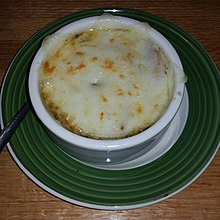
Austrian cuisine is a style of cuisine native to Austria and composed of influences from Central Europe and throughout the former Austro-Hungarian Empire. Austrian cuisine is most often associated with Viennese cuisine, but there are significant regional variations.

Ukrainian cuisine is the collection of the various cooking traditions of the people of Ukraine, one of the largest and most populous European countries. It is heavily influenced by the rich dark soil (chornozem) from which its ingredients come, and often involves many components. Traditional Ukrainian dishes often experience a complex heating process – "at first they are fried or boiled, and then stewed or baked. This is the most distinctive feature of Ukrainian cuisine".

Pennsylvania Dutch cuisine is the typical and traditional fare of the Pennsylvania Dutch. According to one writer, "If you had to make a short list of regions in the United States where regional food is actually consumed on a daily basis, the land of the Pennsylvania Dutch—in and around Lancaster County, Pennsylvania—would be at or near the top of that list," mainly because the area is a cultural enclave of Pennsylvania Dutch culture.

French onion soup is a soup of onions, gently fried and then cooked in meat stock or water, usually served gratinéed with croutons or a larger piece of bread covered with cheese floating on top. Onion soups were known in France since medieval times, but the version now familiar dates from the mid-19th century.

Bulgarian cuisine is part of the cuisine of Southeast Europe, sharing characteristics with other Balkan cuisines. Bulgarian cooking traditions are diverse because of geographical factors such as climatic conditions suitable for a variety of vegetables, herbs, and fruit. Aside from the variety of local Bulgarian dishes, Bulgarian cuisine shares a number of dishes with its neighboring countries, in particular with Turkish and Greek cuisine.

Czech cuisine has both influenced and been influenced by the cuisines of surrounding countries and nations. Many of the cakes and pastries that are popular in Central Europe originated within the Czech lands. Contemporary Czech cuisine is more meat-based than in previous periods; the current abundance of farmable meat has enriched its presence in regional cuisine. Traditionally, meat has been reserved for once-weekly consumption, typically on weekends.

Noodle soup refers to a variety of soups with noodles and other ingredients served in a light broth. Noodle soup is a common dish across East Asia, Southeast Asia and the Himalayan states of South Asia. Various types of noodles are used, such as rice noodles, wheat noodles and egg noodles.

Fricassee or fricassée is a stew made with pieces of meat that have been browned in butter then served in a sauce flavored with the cooking stock. Fricassee is usually made with chicken, veal or rabbit, with variations limited only by what ingredients the cook has at hand.

Pottage or potage is a term for a thick soup or stew made by boiling vegetables, grains, and, if available, meat or fish. It was a staple food for many centuries. The word pottage comes from the same Old French root as potage, which is a dish of more recent origin.

Soup is a primarily liquid food, generally served warm or hot, that is made by combining ingredients of meat or vegetables with stock, milk, or water. Hot soups are additionally characterized by boiling solid ingredients in liquids in a pot until the flavors are extracted, forming a broth. Soups are similar to stews, and in some cases there may not be a clear distinction between the two; however, soups generally have more liquid (broth) than stews.

A meatball is ground meat (mince) rolled into a ball, sometimes along with other ingredients, such as bread crumbs, minced onion, eggs, butter, and seasoning. Meatballs are cooked by frying, baking, steaming, or braising in sauce. There are many types of meatballs using different types of meats and spices. The term is sometimes extended to meatless versions based on vegetables or fish; the latter are also commonly known as fish balls.

Bread soup is a simple soup that mainly consists of stale bread. Variations exist in many countries, and it is often eaten during Lent. Both brown and white bread may be used.

Franconian cuisine is an umbrella term for all dishes with a specific regional identity belonging to the region of Franconia. It is a subtype of German cuisine with many similarities to Bavarian cuisine and Swabian cuisine. It is often included in the Bavarian cuisine, since most parts of Franconia belong to Bavaria today. There are several Franconian food items that are also famous beyond the borders of Franconia, such as Nürnberger Lebkuchen, Bratwurst and the wines of Franconia. Franconia is also famous for its beer and harbours the highest density of breweries in the world.

Swabian cuisine is native to Swabia, a region in southwestern Germany comprising great parts of Württemberg and the Bavarian part of Swabia. Swabian cuisine has a reputation for being rustic, but rich and hearty. Fresh egg pastas, soups, and sausages are among Swabia's best-known types of dishes, and Swabian cuisine tends to require broths or sauces; dishes are rarely "dry".
Cheese soup is a traditional and peasant food from the south of Massif central. Also known as the Aftermath Feast Day Soup, it was brought to the bride and groom's room on their wedding night.

Ashkenazi Jewish cuisine is an assortment of cooking traditions that was developed by the Ashkenazi Jews of Central, Eastern, Northwestern and Northern Europe, and their descendants, particularly in the United States and other Western countries.

Beuschel is a dish that is typically a ragout made from lungs and other organs, such as heart, kidneys, spleen, and tongue, from calf, beef, pork, or game. It is often served with a sour cream sauce and bread dumplings. It is a dish of Viennese cuisine but is widespread in all of Austria, Bavaria, and Bohemia.

















